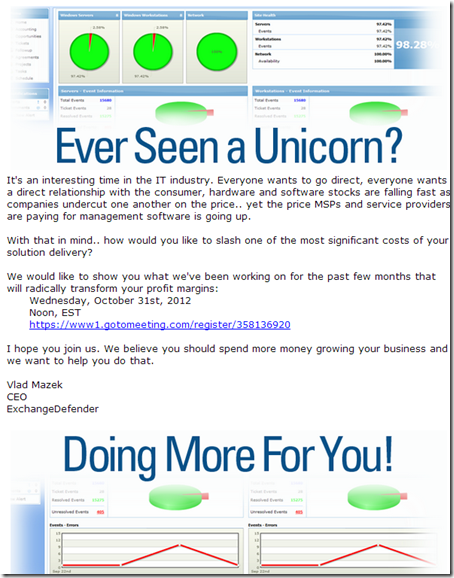Employees spend so much time dealing with the “feedback” (or “blowback”) from their managers that they rarely consider the fact that both sides manage the relationship. This is true in business to business environment between vendors and clients just as much as it’s true between employers and employees or managers and reports. In almost all cases it’s a two way street (unless you work in a sweat shop… in which case you’ll be beaten severely for reading this blog in 3..2..1)
Here are few simple steps for a happier work environment.
Step 1: Know who you work for
Spend some time getting to know your boss, client, vendor.
You’ll find that most people are either polite or outright fake to your face because their interaction with you is purely political and business oriented.
I happen to feel that most people tend to be nice and just want to be happy and do what makes them happy underneath. They just don’t happen to broadcast it.
Find out how people respond so you can differentiate compliments from insults, encouragement from criticism and body language in general.
Step 2: Know when they are having a bad day
Management of time and resources is as important as management of your bosses, vendors and clients.
Know when to skip a step.
Fair warning.. this is about to get a little filthy. 
Step 3: Make it their fault
It’s never the managers fault. Ever. Ever, ever? Ever. Disagree? OK, Fuck you, you’re fired.
If you’d like to argue with the above from an employee perspective, consider the relationship between the vendor and the client. There is no situation, ever, under any circumstance.. where blowing the expectations of the client is a fault of vendors employees. The CEO (boss, etc) is ultimately responsible for what the company does.
There are no excuses.
Oh, you didn’t know what was going on in your company? You are an idiot.
Oh, your staff is incompetent and they made a mistake? Who hired them, who implemented controls, who reviewed or monitored te execution – you are an idiot.
<insert excuse> – … idiot.
Now that we’ve covered the fact that there is responsibility and accountability at every level and in every relationship, it follows that he who has the control over the job being done is ultimately the one that is responsible. Read that again. Since the receiving party has no actual direct influence over the deliverable, they get to feel happy/sad about what they receive from you.
Now.. that’s not really fair, is it? Your schedule might be packed. You may not have the resources. You might be feeling under the weather, problems at home, losing money in the stock market, found out the kid wasn’t yours, woke up in a ditch feeling sore, you adopted a dog that ate your car keys.. hey, shit happens. This is why you have to find a way to make it their fault.
 But how? How do you twist a terrible situation into not being blamed for it? Simple: Get tons of feedback and make it exactly what they want.
But how? How do you twist a terrible situation into not being blamed for it? Simple: Get tons of feedback and make it exactly what they want.
Nobody.. ever.. ever.. woke up and said.. “You know what… I want a $60,000 Mazda Miata with a poop colored interior and 4th day of my period toned roof on top of a silver car.” – But Porsche sold thousands of them!
Friends.. simply put, it’s what the customer wanted.
As an employee, your job is to meet expectations. No matter how ridiculous those expectations and demands may be, your job is to make your boss happy. If they are happy, you’re happy. Yeah, from time to time it might make you want to cover your eyes or look away every few seconds as if someone tied you down to watch 2 girls 1 cup video.. but recognizing what your job is and the fact that you do not have all the perspective that your boss may have is what it takes to win and hopefully get promoted as far away as possible.
How.
Go through steps 1-3.
Solicit input. You’ll never know what is actually expected of you if you don’t ask. Ask for as many specifics as you can reasonably expect a clear answer to and pay attention to the details. Are they offering a lot of details about a particular aspect of your deliverable – that means they know exactly what they want. Are they being vague – they have no idea what they want.
Offer options. Everyone has an opinion. Unfortunately, most opinions are stupid. By providing lots of different alternatives you have a way of playing hot and cold with the boss or the client.
Offer revised options. Based on the feedback from the previous step – offer revised options. See if you’re going in the right direction or if they change their mind. Reasonable people often change their mild – wildly – when they are proven wrong. There are no geniuses, just people with tons of options and the luck to choose the right one. Some people make great choices. For the rest, there is a poop colored Porsche.
Make them choose and give them the alternatives as well. Once your boss and client have made their choice, spend all the time you’ve got into making their choice the best it can be. Spend 10% of your time working on the other options as well. You never know, maybe they will change their mind down the road – as much as you want to give them choices initially, you want to also provide them with a way to provide choices to whomever they are trying to sell their idea to as well.
Provide vague progress reports. Never, ever, ever, ever, ever be specific about what is going on. It invites micromanagement. Worse, it lets them know just how much of your time is spent taking what we at Own Web Now call “Frankcation at the keyboard” – an act of being at work but also working at such a slow pace that you might as well be on vacation. Or pinterest. Try to be a sales guy – they provide for a perfect shitstorm of vague information: lack of intellect combined with compulsive lying and D+ math skills. This is also known as downplaying your pipeline – you want the expectations to be so low that just the miracle of getting your job done is a positive. Instill confidence at the same time as you distribute doubt:
“Yeah, I’m almost done with it, I’d love to show it to you but Bob messed up my PC so I’m waiting for the patch.”
This bait and switch is terrific because not only does it make them feel good about what you’re doing but it makes them go and unleash their frustration on Bob who let’s face it, is likely on the shitlist to start with. So long as Bob isn’t an axe murderer this is known as a corporate win-win-win.
Only show it when it’s done. Never, ever, ever show your work in progress. It will only prompt more feedback, more ideas, more suggestions and it will give your boss/client a sense that things could still be tweaked. God help you, that project is never getting done. Only show them the finished masterpiece – make them ride that Poop Period Porsche off the lot with pride!
Conclusion
The few of you that are sensible.. or naïve.. might look at all this and find it completely defeating and sad. It is. Yet, this is the nature of how things get done among imperfect people, mismanaged companies, unmotivated workforce and diversity in general.
Maybe Poop Porsche isn’t for you? But it beats a Ford Model T “in any color you want so long as it’s black” any day.
I find that most people struggle and get demotivated by the things they cannot change – yet refuse to tinker with so many things that are in their control.
You can be happy and you can put out great stuff – so long as you are willing to put in the extra effort and be a part of the solution. World already has enough mindless drones following the management pyramid and most of them work at Foxconn and sweatshops where there are occasionally suicides.
The choice to do better starts with you. Happy Monday.







 For the less coherent, more grammatically correct realtime insight, follow me on Twitter at
For the less coherent, more grammatically correct realtime insight, follow me on Twitter at